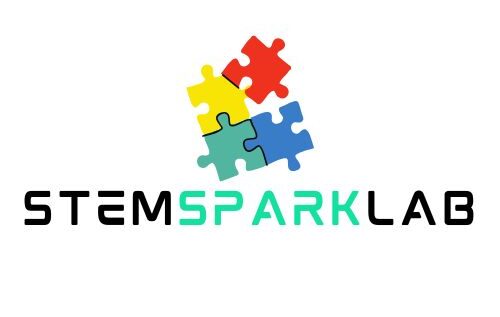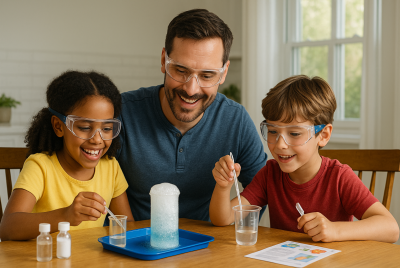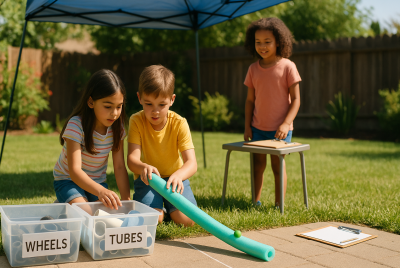5 Simple Fall STEM Activities You Can Do With Kids
We may earn a commission for purchases made using our links. Please see our disclosure to learn more.
You know that dreamy fall picture in your head—crunchy leaves, pumpkins on the porch, kids actually learning instead of melting into screens?
Then real life hits: homework, dishes, 10 tabs open in your brain… and suddenly “doing STEM” feels like one more thing on your overflowing list.
Here’s the good news: Fall STEM Activities don’t have to be fancy, expensive, or teacher-level perfect. With leaves, apples, pumpkins, and a few basic supplies, you can turn ordinary autumn moments into quick, meaningful STEM time that actually fits into real life.
Why Fall STEM Activities Matter
Fall is basically a free outdoor STEM lab:
- Leaves change color → chemistry and plant biology
- Weather swings from warm to windy → data, prediction, patterns
- Harvest themes → measurement, life cycles, engineering
Hands-on STEM activities help kids remember and understand more than just listening or watching. Studies on hands-on learning show that physically doing tasks can boost recall and engagement compared to traditional demonstration-only teaching.
Add in cooler weather, cozy drinks, and more time indoors, and autumn becomes the perfect season to build a simple, doable STEM rhythm with your kids.
Simple Setup for Stress-Free STEM
Before we jump into specific autumn STEM activities, make a tiny “STEM stash” so saying yes is easy. Toss into a basket:
- Clipboard and scrap paper
- Pencils, markers, tape
- Ruler or measuring tape
- Magnifying glass
- Small containers or bags for collecting nature items
- Baking soda, vinegar or lemon juice, and food coloring
This doesn’t need to be Instagram-level. The real goal is to remove friction. If you can grab a basket and step outside in under a minute, you’ll actually use these ideas.
Leaf Investigation Lab
This is your go-to “we have 20 minutes and a pile of leaves” activity.
How to do it
- Collect 10–20 leaves on a short walk.
- Spread them out on a table or floor.
- Ask kids to sort them:
- By color (green, yellow, red, brown)
- By size (small, medium, large)
- By shape (smooth, jagged, lobed)
- By color (green, yellow, red, brown)
- Make a simple chart or bar graph of what they found.
STEM skills: observation, classification, early data handling, comparing quantities.
To stretch it for older kids, have them look closely at leaf veins and symmetry, then sketch and label a “scientist-style” leaf diagram.
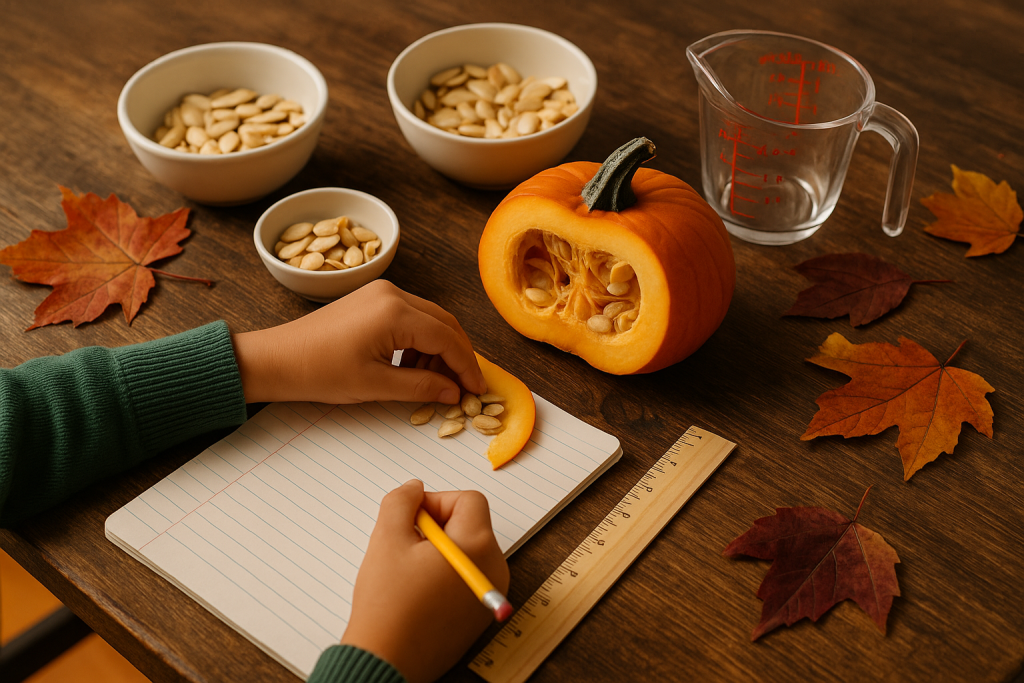
Pumpkin STEM Station
Pumpkins are basically fall’s STEM MVP. You can turn one pumpkin into several fall science experiments.
Ideas to mix and match:
- Seed estimation: Guess how many seeds are inside, then count in groups of 10. Compare guesses to the real number.
- Pumpkin towers: Use mini pumpkins and popsicle sticks to build the tallest stable tower. Talk about balance and wide bases.
- Pumpkin goo volume: Scoop out the insides, estimate the volume, then measure using cups or a measuring jug.
Kids just think it’s delightfully messy. You know it’s sneaky math, engineering, and sensory science.
Backyard Weather Watchers
Fall weather is ideal for simple weather STEM activities.
You can:
- Make a windsock from a plastic bag and string.
- Use a clear jar with a ruler taped to the side as a rain gauge.
- Take the temperature at the same time each day and track it over the course of a week.
Ask kids to:
- Predict the day’s weather each morning.
- Record what actually happens.
- Compare predictions with reality—were they close?
Over a few weeks, you’re building real skills in observation, data collection, and pattern spotting.
Apple STEM Challenges
Apples are cheap, seasonal, and surprisingly powerful for fall STEM projects.
Apple tower challenge
- Cut apples into chunks or rings.
- Add toothpicks and challenge kids to build the tallest tower that won’t tip.
- After a “crash,” talk about what made it unstable and how to redesign.
Apple browning experiment
- Slice an apple into several pieces.
- Put each piece in a different cup:
- Plain air
- Lemon juice
- Salt water
- Plain water
- Plain air
- Check every 10–15 minutes.
- Ask: Which one turned brown fastest? Which stayed light longest?
You’re touching on oxidation, variables, and “fair tests” without needing a lab.
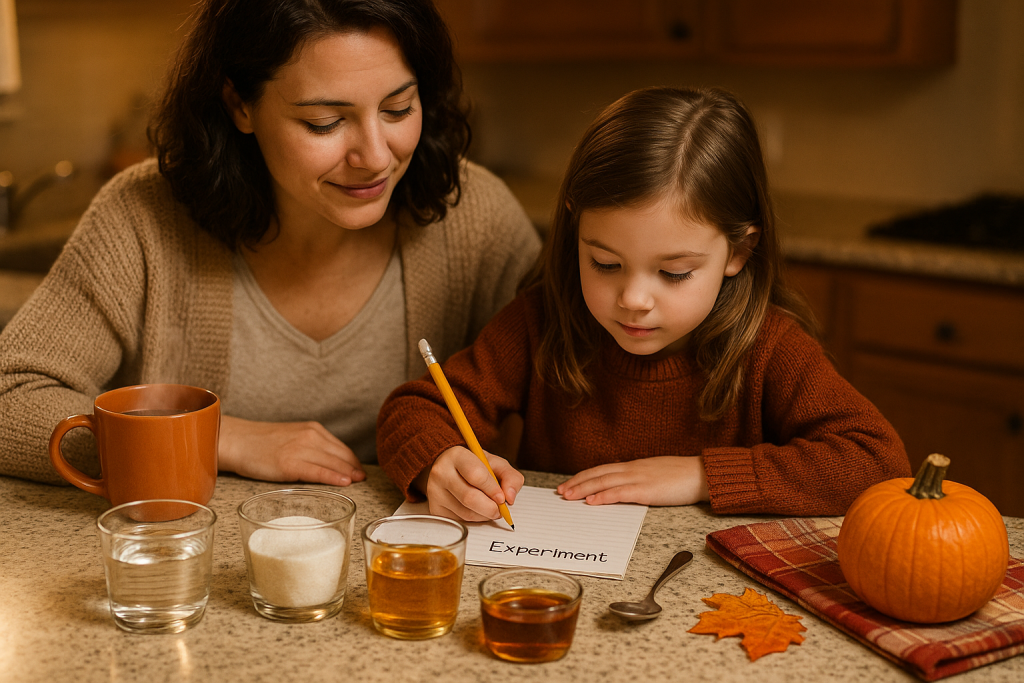
Nature Walk Data Hunt
If your kids love checklists, this one’s for them.
Create a simple tally sheet with boxes for:
- Red leaf
- Yellow leaf
- Brown leaf
- Acorn
- Pinecone or seed pod
On a short walk, kids make a tally each time they spot one. Back home, they:
- Turn tallies into a bar graph.
- Talk about what was “most common” and “least common.”
- Predict how the graph might change in winter or spring.
You’ve just done math, data, and outdoor STEM in one go.
Cozy Kitchen Chemistry
When it gets chilly, move STEM into the kitchen.
Easy ideas:
- Test how fast sugar, honey, and maple syrup dissolve in warm water.
- Compare a metal spoon and a wooden spoon in hot water—which gets hot faster?
Then connect it to real life:
- Why do we use oven mitts on metal pans?
- Why are some mugs double-walled?
These little fall science experiments make everyday objects feel more interesting—and a lot more “science-y.”
Mini Forest Terrariums
Terrariums are like tiny forests kids can actually take care of.
You can:
- Layer pebbles, soil, and moss in a clear jar.
- Add a small plant or quick-sprouting seeds.
- Mist with water and watch condensation and growth over days and weeks.
For a ready-made option, the Creativity for Kids Plant and Grow Woodland Forest: Terrarium Kit lets kids decorate a mushroom-shaped terrarium and grow chia seeds that sprout in just a few days, combining craft and plant science in one project.
Magnetic STEM for Little Learners
Got toddlers or preschoolers who still mouth everything? You can still do Fall STEM Activities—just keep it chunkier and more tactile.
The Woodtoe Montessori Toys for 3–6 Year Old, Pumpkin Picking Magnetic Leaves Tree Toy is a wooden board where kids use a magnetic wand to “pick” pumpkins and leaves. It supports color sorting, counting, and fine motor work while staying totally on-theme for fall.
Pair it with real leaves outside:
- Match wooden leaves to real ones by color or size.
- Time how many magnets they can “harvest” in 30 seconds and compare scores.
Using Science Kits to Extend Fall STEM
On days when you’re tired or planning time is… nonexistent, science kits can keep STEM going without extra prep.
Look for kits that:
- Are open-ended (not a “one and done” activity)
- Have short experiment times (15–30 minutes)
- Connect to things kids already notice in fall—weather, plants, light, color
If you want ideas in one place, check out this roundup of hands-on science kits for kids that work well at home or in a classroom. Use them as backup: rainy days, after-school “lab time,” or a monthly family STEM night.
Amazon STEM Picks for Fall
Here are five fall-friendly STEM products that pair beautifully with the activities above. Always check current details, age ranges, and prices on the product page before buying.
Woodtoe Montessori Toys for 3–6 Year Old, Pumpkin Picking Magnetic Leaves Tree Toy
A wooden board with magnetic pumpkins and leaves kids “pick” using a wand—great for harvest-themed fine-motor work.
- Features: Wooden base, magnetic wand and pieces, fall harvest design
- Pros: Builds fine motor skills; very seasonal; screen-free
- Cons: Small pieces need supervision with younger siblings
- Best for: Ages 3–6 who love hands-on, tactile STEM
Review snapshot: Buyers like the sturdy feel and cute theme; some wish there were a storage bag for the small pieces.
Kids Pumpkin Garden Kit – Grow Your Own Pumpkins from Seeds
A kid-friendly gardening kit with non-GMO pumpkin seeds, greenhouse domes, and grow rings so kids can start their own mini pumpkin patch.
- Features: Non-GMO seeds, small domes, plant markers, instructions
- Pros: Connects porch pumpkins to real plant science; teaches patience
- Cons: Results depend on weather and care; not instant gratification
- Best for: Elementary kids curious about gardening and life cycles
Review snapshot: Families love seeing kids’ excitement when sprouts appear; some recommend starting indoors for better success.
Creativity for Kids Plant and Grow Woodland Forest: Terrarium Kit
A mushroom-shaped terrarium kit with chia seeds and woodland decorations that blend craft and science.
- Features: Terrarium container, chia seeds, soil, gravel, figures, stickers
- Pros: Quick-sprouting plants; doubles as fall decor; highly engaging
- Cons: Can be messy to set up; younger kids need help reading directions
- Best for: Ages 6+ who love mini worlds and nature crafts
Review snapshot: Reviewers highlight the fast plant growth and “wow” factor; a few mention needing to watch moisture levels to avoid mold.
Thames & Kosmos Weather and Climate Lab
A compact weather station kit that lets kids measure wind, rain, and temperature while exploring meteorology through experiments.
- Features: Components for a 5-in-1 weather station, experiment guide
- Pros: Pairs perfectly with fall weather tracking; builds real data skills
- Cons: Some assembly and outdoor setup required
- Best for: Elementary and middle school kids interested in weather
Review snapshot: Parents and teachers appreciate the educational value and repeatable experiments; a few want more durable outdoor mounting options.
Tissue Paper Leaf Craft Kit
A craft kit for making “stained glass” style tissue paper leaves that hang in windows—perfect after a leaf investigation walk.
- Features: Foam leaf shapes, acetate sheets, tissue paper, ribbon hangers
- Pros: Simple setup; explores light, color, and transparency
- Cons: One-time use; tissue scraps can get everywhere
- Best for: Small groups or classrooms decorating windows for fall
Review snapshot: Buyers like that it’s easy for younger kids but still pretty enough for older ones; some suggest working over a tray to contain tissue bits.
Quick Comparison Table
| Model | Key Spec(s) / Activity | Warranty Info* | Approx Price/Tier | Best For |
| Woodtoe Pumpkin Picking Magnetic Leaves Tree Toy | Wooden magnetic fine-motor board with fall theme | Check listing for seller warranty | $–$$ | Preschool fine-motor and early STEM |
| Kids Pumpkin Garden Kit | Non-GMO pumpkin seeds, grow domes, garden starter set | Warranty/guarantee varies by seller | $$ | Elementary gardeners & life-cycle projects |
| Plant and Grow Woodland Forest Terrarium | Mushroom terrarium, chia seeds, craft + plant science | Manufacturer/seller warranty listed on product page | $$ | Ages 6+ nature and craft lovers |
| Thames & Kosmos Weather and Climate Lab | Weather station components and meteorology experiments | Manufacturer warranty; see packaging/listing | $$–$$$ | Weather-obsessed elementary/middle graders |
| Tissue Paper Leaf Craft Kit | 9″ foam leaves, acetate, tissue, ribbons (makes 12) | Warranty and return policy via retailer | $ | Classrooms and co-ops doing fall décor |
*Always confirm current warranty and price details on the product page—they can change over time.
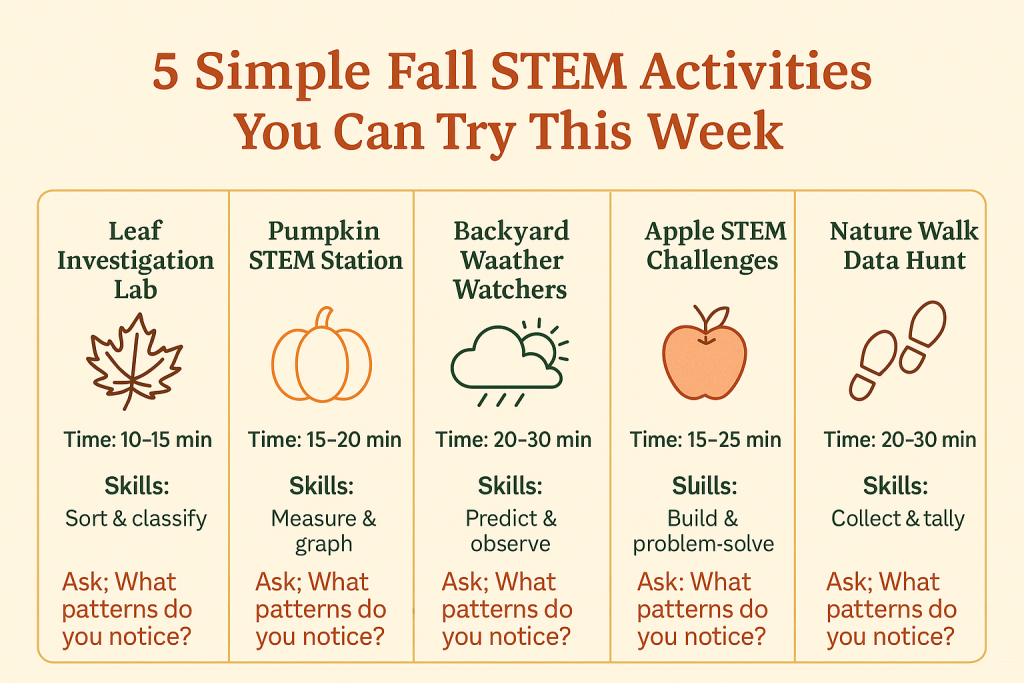
Research-Backed Benefits of Fall STEM
If you like knowing the “why” behind what you’re doing, this part is for you.
- A study published in the American Journal of Occupational Therapy found that children who learned through hands-on occupations remembered more steps, in order, than those who only watched demonstrations. That’s exactly what you’re doing when kids actually scoop pumpkin seeds, build apple towers, or test which cup of apple slices browns first.
- An integrative review in Frontiers in Psychology pulled together hundreds of studies and concluded that experiences in nature can boost academic learning, personal development, and environmental stewardship. Your leaf walks, weather tracking, and outdoor data hunts are way more than “fresh air”—they’re linked to better learning outcomes.
Reviews of outdoor and environmental education also show that learning outside can support science achievement and build critical thinking, teamwork, and problem-solving skills.
So when you spend 20 minutes on a nature graph instead of another worksheet, you’re not “falling behind.” You’re using strategies that research actually supports.
Adapting Fall STEM for Different Ages
The best part about Fall STEM Activities? You can run the same activity at different depths.
- Toddlers / Preschoolers
- Focus on textures, colors, and big movements.
- Let them sort big leaves, scoop seeds, or pour water.
- Focus on textures, colors, and big movements.
- Early Elementary
- Add counting, simple measuring, and bar graphs.
- Ask them to make predictions and compare to results.
- Add counting, simple measuring, and bar graphs.
- Upper Elementary / Tweens
- Encourage them to design or tweak experiments (“What if we changed the liquid?”).
- Have them explain results in their own words or in a short journal entry.
- Encourage them to design or tweak experiments (“What if we changed the liquid?”).
- Kids with sensory differences
- Offer gloves for gooey tasks.
- Use visual checklists and clear steps.
- Let them choose observation roles if touching certain textures feels overwhelming.
- Offer gloves for gooey tasks.
Think of these activities like layers—you add or remove detail to match each child, not the other way around.
FAQs About Fall STEM Activities
How do I start Fall STEM Activities if I’m not “good at science”?
Begin with super simple ideas: leaf sorting, an apple browning test, or a rain gauge in a jar. You don’t need perfect explanations; “I’m not sure—let’s find out together” models real scientific thinking.
What are some easy Fall STEM Activities I can do today?
Try a leaf investigation, apple tower challenge, or tally-and-graph nature walk. All three use everyday materials and take 15–30 minutes.
How can I keep Fall STEM Activities budget-friendly?
Use what you already have: leaves, apples, jars, spoons, baking soda, vinegar, and scrap paper. Free nature items are incredible tools for autumn STEM activities. Kits are optional, not required.
Can these activities work for mixed-age groups?
Yes. Younger kids can collect and sort; older kids can measure, record data, or explain what happened. Same activity, different responsibilities.
What if the experiment “fails” or doesn’t go as planned?
That’s still STEM. Ask what they think happened and what they’d try next time. Real science includes mistakes, weird results, and do-overs—it’s not a sign you did it wrong.
